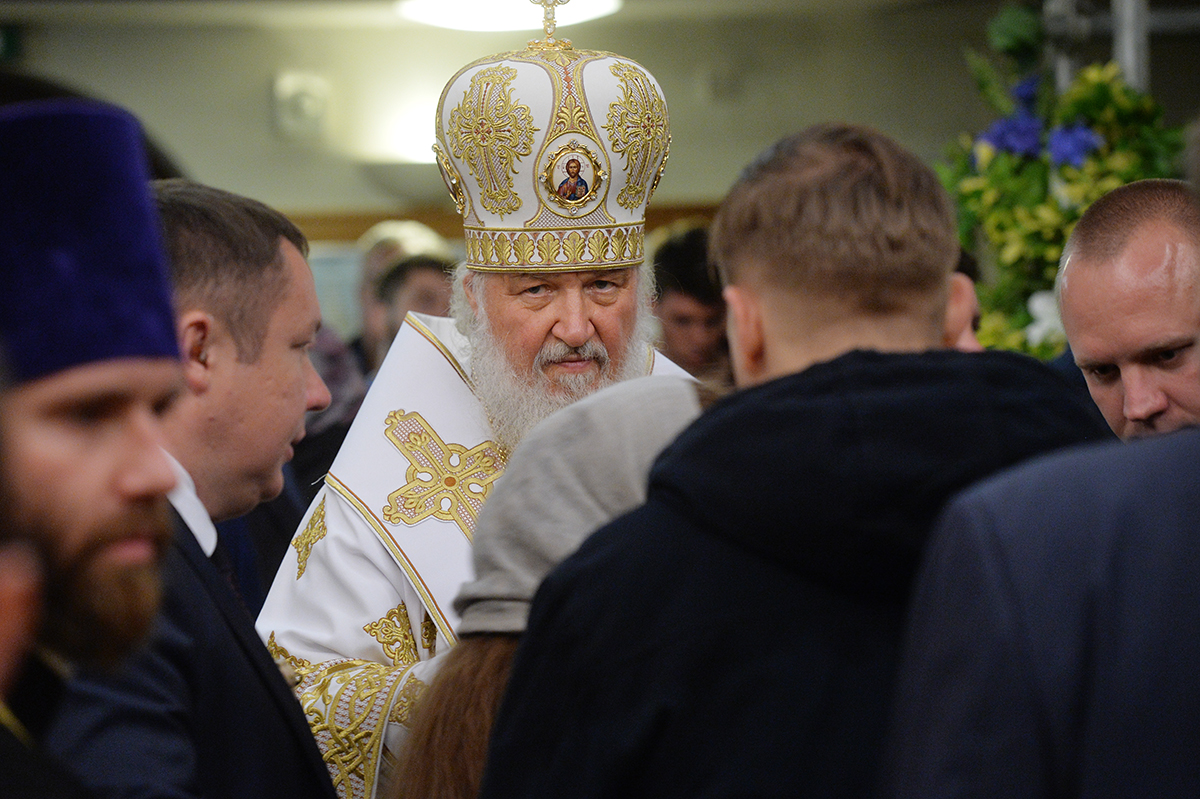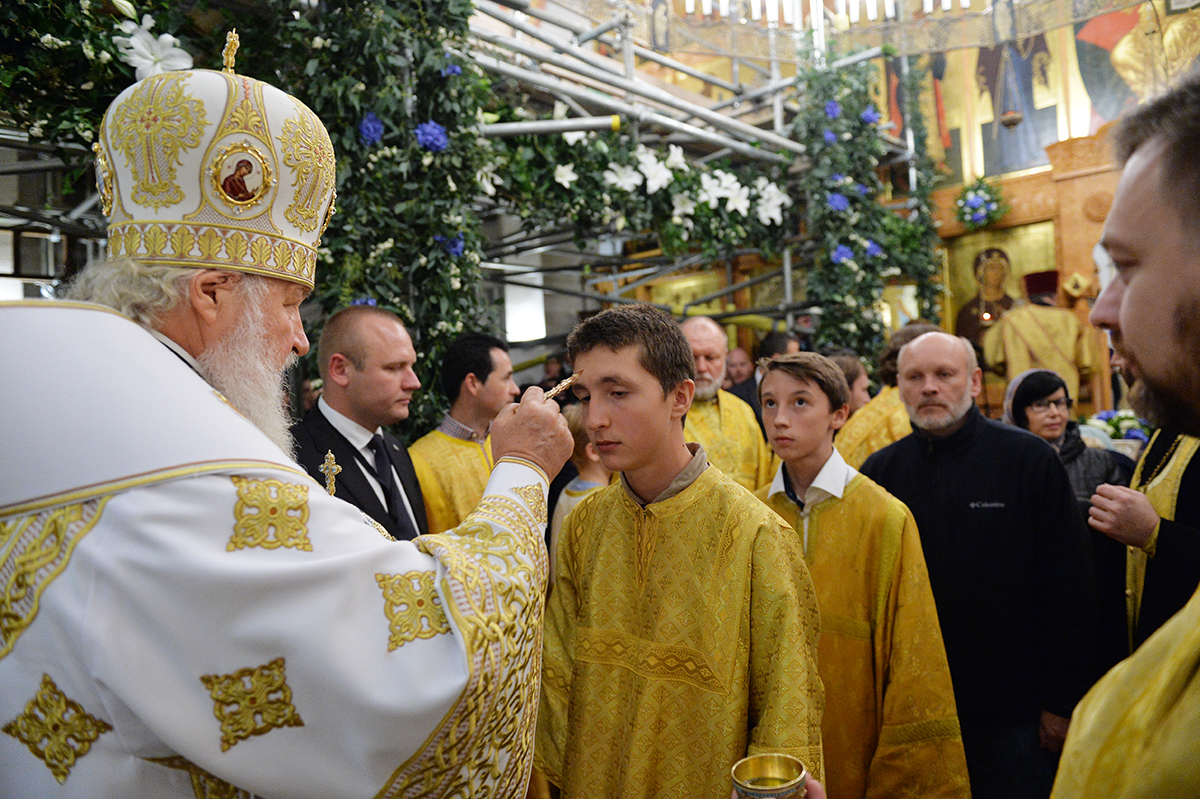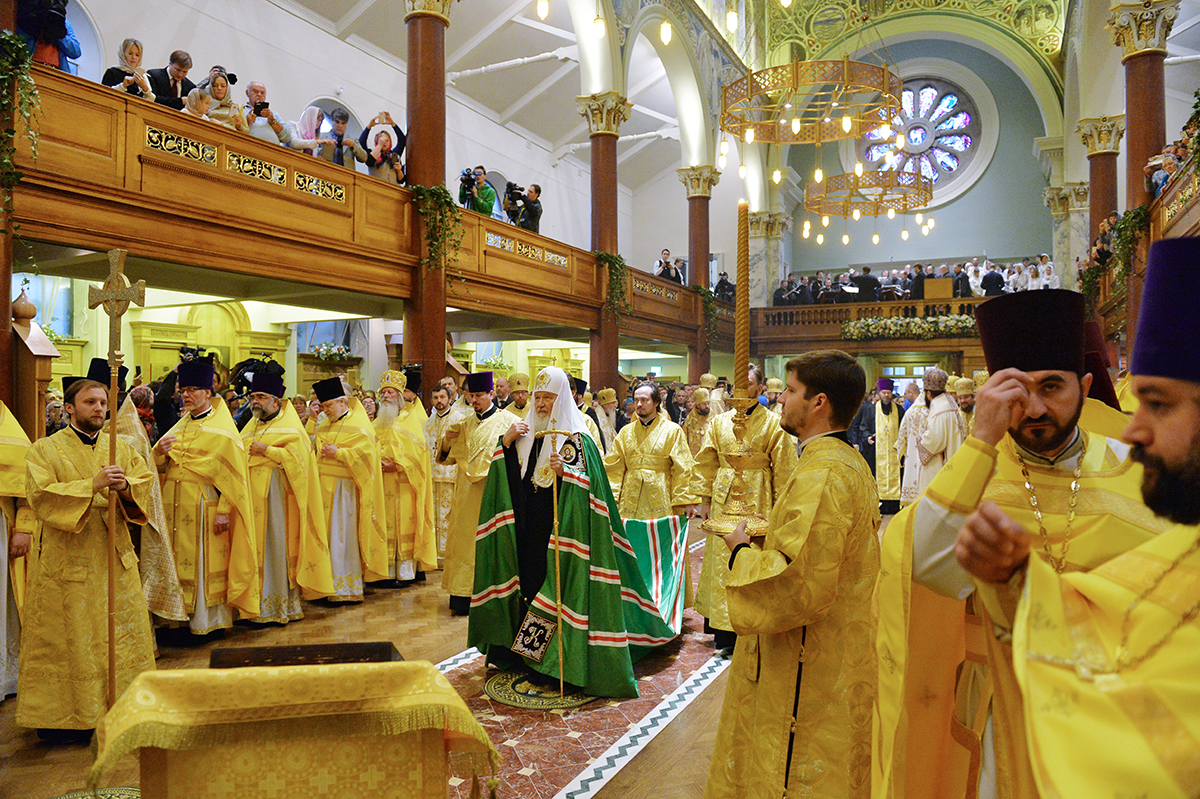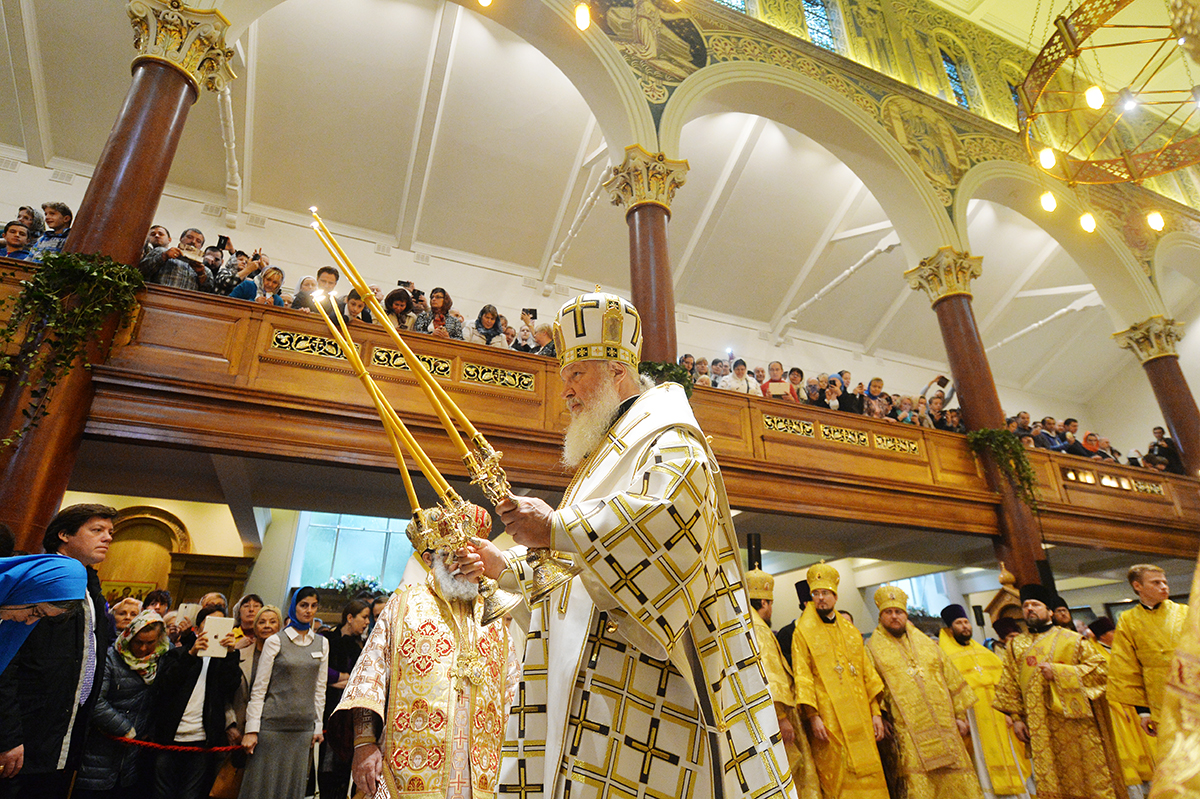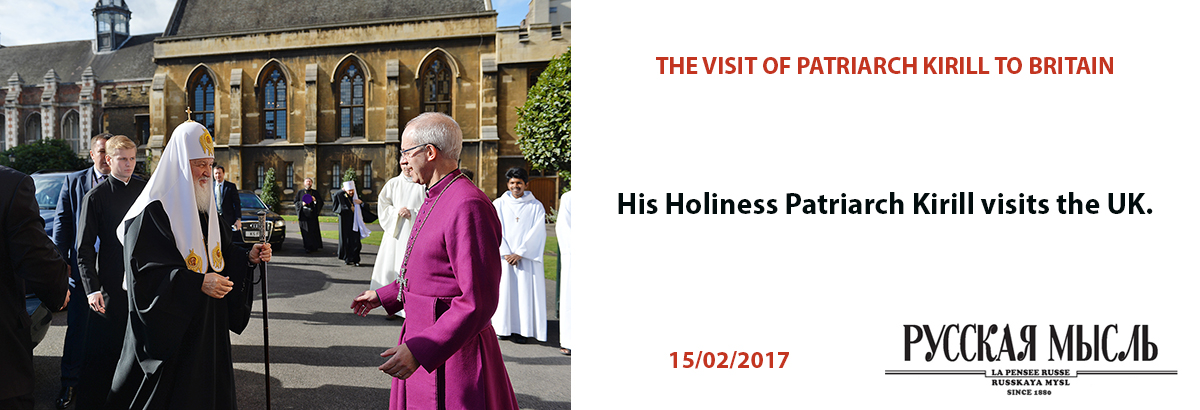Patriarch Kirill: ‘The Church unites people, transcending national, social and political confines.’
The event for which the clergy and lay people of the Cathedral of the Dormition have been eagerly preparing throughout the whole year has finally taken place: from 15th to 18th October 2016 His Holiness Patriarch Kirill of Moscow and all Russia visited Britain.
This visit was the culmination of the celebration of the 300 years of the presence of the Russian Orthodox Church in Great Britain and Ireland. Since, in accordance with the church canons, it was necessary to perform the Great Consecration of the Cathedral following the major refurbishment that has taken place in recent years, it was planned for the consecration to be performed by the Patriarch.
HISTORIC MOLEBEN (PRAYER SERVICE) IN THE OLD EMBASSY CHURCH
On 15th October at midday the first photographs of the Patriarch in London appeared in the media. His Holiness was met at the airport by A. Yakovenko, the Ambassador of Russian Federation and Archbishop Elisey of Sourozh. The Patriarch arrived in Britain accompanied by Metropolitan Hilarion of Volokolamsk, chairman of the Moscow Patriarchate’s Department for External Church Relations; Archbishop Mark of Berlin, Germany and Great Britain; Archbishop Michael of Geneva and Western Europe; Bishop Sergiy of Solnechnogorsk, head of the Moscow Patriarchate’s Administrative Secretariat; Archbishop Elisey of Sourozh; and Bishop Antony of Bogorodsk, head of the Moscow Patriarchate’s Administration for Institutions Abroad, Alexandr Volkov and some other officials. Many of them were already well known to the parishioners of the Diocese of Sourozh since they have served here or been frequent guests.
The historical chapel at 32 Welbeck Street that served as the Embassy church from 1813 till 1921 was opened to visitors on 15th-16th October. Currently it is a medical centre (Circle Centre ) and there is no public access to the building. Fortunately, the building is in good condition and the icons and paintings on the columns and under the dome have been preserved. At midday Priest Dmitry Nedostupenko served a moleben of historical significance (the first one in a hundred years), which was attended by many faithful.
The historian Mikhail Sarni spoke about the story of this church and its furnishings. He is the author of several books about the history of Russian Orthodoxy in Britain and Ireland and has also published various works in different periodicals and popular science publications. Following the service, an exhibition ‘Romanovs in the First World War: Saints and Heroes’ was opened in the chapel. The exhibition is the culmination of many years’ of work and studies by Maria Harwood, the president of the Community of the Holy Martyr Grand Duchess Elizabeth and a member of the Diocese of Sourozh.
Throughout the day new visitors kept arriving at the chapel and asking Maria about Russian-British connections during World War I, the sisters of mercy drawn from the members of the Royal family and especially the Holy Martyr Grand Duchess Elizabeth, who spent her childhood with her royal grandmother – Queen Victoria. It is well known that the future Russian Duchess was half English. Later, the Duchess established the Martha and Mary Convent in Moscow, which looked after orphans and those in need until the Russian Revolution.
By 5 o’clock the chapel was again filled with faithful: everybody was expecting the arrival of Patriarch Kirill for the moleben. There were quite a few reporters present who were covering the visit of His Holiness. It seemed that everyone was in a special spiritual of state of mind. The place where the Russian Emperors, Nicholas I, Alexander II and the Holy Passion-Bearer Tsar Nicholas II prayed, where our compatriots, who like us found themselves by the force of destiny in far-off England, gathered to entreat the Lord for help in a foreign land, to pray for their relatives who remained at home in the motherland; this place heard also our prayers, led by the Patriarch of the Russian Church, the largest of the Orthodox Churches.
Archbishop Elisey of Sourozh expressed his gratitude to His Holiness the Patriarch for coming to Great Britain and for the moleben celebrated in a place so significant for Russian Orthodoxy: ‘Our ancestors and compatriots were praying here in this church, offering their sacrifices at the altar. It is a place where people were weeping, but also a place where people were happy. For the first time His Holiness the Patriarch has visited this place. We have preserved this iconostasis that was here. With great gratitude we address you, Your Holiness, since you have hallowed this place with our common prayer.’
In return, His Holiness the Patriarch said that although it was not his first visit to Great Britain, previously he had not had a chance to visit this particular place – the cradle of Russian Orthodoxy in London. During the moleben the Patriarch commemorated those who made the way for Russian Orthodoxy in Great Britain. As is well known, in the 1920s the parishioners left this building as the parish had grown considerably due to the new wave of Russian immigrants.
MATINS AT THE ALL-NIGHT VIGIL IN THE CATHEDRAL OF THE DORMITION OF THE MOTHER OF GOD AND THE HOLY ROYAL MARTYRS IN CHISWICK
After blessing all the faithful, His Holiness departed to the Dormition Cathedral of the Russian Orthodox Church Abroad in Chiswick. For many years now, we have rejoiced to share Eucharistic communion with the parishes of the Russian Orthodox Church Abroad. Many parishioners of the Dormition Cathedral in Kensington also regularly attend the services at the Dormition Cathedral in Chiswick. Therefore, many people followed the Patriarch from the church in Welbeck Street to Chiswick in order to pray during Matins at the All-Night Vigil.
Following the divine service, His Holiness the Patriarch addressed the faithful: ‘When the tragedy occurred in our homeland and the nation divided, and the country divided, it affected the life of our long-suffering Church. We know that far back as 1927 our church community divided: some followed Metropolitan Evlogy (Georgiyevsky); others, the Synod of the Church Abroad. The division that existed for many decades was in a spiritual and in an ecclesiastical sense not a real schism, but a superficial scar on the body of our Church, and was overcome by God’s mercy. And today there is one Russian Orthodox Church, and I as Patriarch never divide parishes into patriarchal ones and foreign ones, because for me they all are parishes of the one Russian Orthodox Church. Today, looking at your faces, I have seen the same people that fill our parishes everywhere, be it in England, Europe, America, or Russia. These are our Orthodox faithful and by God’s blessing they are now under the spiritual care of the one Russian Orthodox Church.’
GREAT CONSECRATION OF THE CATHEDRAL OF THE DORMITION OF THE MOTHER OF GOD AND THE DIVINE LITURGY
The faithful of the Dormition Cathedral were waiting impatiently for the morning of the following day, October 16th. Nobody was put off by the weather conditions: despite cool rain and humidity the church was full of people; the church’s galleries also held worshippers and believers kept arriving at the square in front of the church. For them, to miss the blessing of the new church bells, the Great Consecration of the cathedral and the Divine Liturgy headed by the Primate of the Russian Orthodox Church was out of the question. It would be correct to note that an event of this significance happens once in 300 years. ‘These bells are blessed and sanctified by the grace of the Holy Spirit, through the sprinkling with this holy water, in the name of the Father, the Son and the Holy Spirit. Amen!’– exclaimed the Patriarch before ringing a bell three times.
Some of the bells carry depictions of the saints and one has the portrait of Queen Elizabeth II and the inscription ‘God Save The Queen’. Prayers for the Queen, the British government and the armed forces are said regularly during each Liturgy in the Dormition Cathedral – a tradition, like that of having services in both Church Slavonic and English, established by Metropolitan Anthony of Sourozh.
Careful preparations had been made for the long-awaited consecration of the Dormition Cathedral: a new iconostasis had been erected which was created with supreme artistic sense and in total harmony with the existing Victorian adornments of the church including the sgraffito. The icons are made in a Byzantine style that conveys a sense of deep internal calmness and grandeur.
Moreover, the icons that were previously kept in the small church were installed in alcoves along the walls of the cathedral. Special alcoves with bulbous-shaped domes and crucifixes on top were erected on the columns where icon stands used to be. It unobtrusively creates an atmosphere of a deeply Orthodox church, without spoiling the initial idea of the architect and the overall composition of the cathedral. The church was gracefully decorated with floral compositions. Every corner of the church and the surrounding buildings was sparking clean and looked splendid.
For those who remained standing outside the church there was a big screen installed with a live transmission of what was happening inside the church during the ivine service.
The Liturgy was attended by several invited guests, including Prince Michael of Kent, Archbishop of Canterbury Justin Welby and Bishop of London Richard Chartres (Church of England), the Apostolic Nuncio in Great Britain Archbishop Antonio Mennini and Archbishop Kevin McDonald (Roman Catholic Church), Bishop Angaelos (the Coptic Orthodox Church), Bishop Hovakim Manukyan (Armenian Church), Metropolitan H.E. Mor Athanasius Toma Dawood Dakkama (Syrian Orthodox Church). It is gratifying to note that during the Liturgy the distinguished guests were attentively following the service and reverently crossing themselves. During a short pause Prince Michael spoke with Patriarch Kirill in Russian.
Amongst those who were concelebrating with His Holiness were the members of the delegation from the Russian Orthodox Church and various clergymen of the Diocese of Sourozh who came for the festive Liturgy from all parts of Great Britain and Ireland. Several hierarchs of the Local Orthodox Churches: Bishop Athansios of Tropaeou (Ecumenical Patriarchate of Constantinople), Metropolitan Silouan of the British Isles and Ireland (Antiochian Patriarchate), Metropolitan Iosif of Western and Southern Europe (Romanian Orthodox Church) also concelebrated. Metropolitan Kallistos of Diokleia (Ecumenical Patriarchate) was praying in the altar. Amongst those who concelebrated were also Archbishop Anatoly of Kerch, Bishop Matfey of Skopin and Shatsk, and Bishop Flavian of Cherepovets and Belozersk, all beloved of the faithful of the Diocese of Sourozh. Fr Mikhail Dudko who used to serve in the Dormition Cathedral and Fr Dimitry Karpenko, Acting Secretary of the Diocesan Administration of the Diocese of Sourozh and also continuing to serving in the Diocese of Gubkin also came to take part in the celebration.
The sermon of Archpriest Stephen Platt, Rector of Saint Nicholas church in Oxford penetrated the hearts and minds of those who were present – everyone reflected upon the church being the home where God’s joy lives. The words of Apostle Paul from his Epistle to the Philippians came to mind: ‘Rejoice in the Lord . . . and again I say, Rejoice’ (Phil. 4:4). In his sermon, Fr Stephen reminded us that the Church is not just a building; it consists of three temples, the meaning of which he proceeded to explain.
Holy Communion was given from nine chalices and recalled the Liturgy of the early Christians when the whole church participated in this sacrament. Following the Liturgy, Archbishop Elisey of Sourozh expressed his gratitude to His Holiness for the visit, the consecration of the cathedral and presented His Holiness with a patriarchal crozier made in a style that combines Celtic and Early British motifs characteristic of the Orthodox Christianity that existed in the British Isles before the tragic division of Christendom.
In his turn, His Holiness the Patriarch presented to the Dormition Cathedral an ancient icon of the Mother of God, It is Truly Meet and gave all those who were present small icons of All the Saints of the British Isles and Ireland with his patriarchal blessing. Nobody was left unnoticed: the icons were also given to those who were standing outside the church.
His Holiness addressed the faithful with words in which he underlined that we give thanks to God for that we have had to live through. We give thanks to Him for afflictions and joys, we give thanks to Him for the unique experience of the spiritual life of our people: ‘The Church has special importance for peoples’ spiritual lives. She unites people, transcending national, social, property and political confines. By her nature the Church cannot align herself with either the right or the left or the centre. She cannot be with the wealthy against the poor, or the poor against the wealthy. She cannot be with representatives of one nationality against another. The Church is the community which is open to the world. And all human contradictions are erased in this community. And even very wealthy people stand alongside the poor and the highly-placed alongside the simple as a sign that within the Church these differences and contradictions are swept aside…’
The chanting was especially solemn and beautiful on this day: the Clergy Choir of the Saint Petersburg Metropolis under the direction of Yuriy Gerasimov and the Choir of Dormition Cathedral under directed by Kirill Krayushkin.
After the celebrations in the cathedral, His Holiness attended a photographic exhibition in the Royal Geographic Society of which he became a member and was scheduled to read a lecture in front of the parishioners. Unfortunately, the fire alarm forced everybody to leave the building. However, on the bright side, these circumstances made it possible for His Holiness to communicate with people in an informal atmosphere. The Patriarch received his certificate of membership of the Royal Geographic Society from the Keeper of the Collection, Alaistair McLeod.
In his speech of thanks the Holy Patriarch said, ‘During my life I have managed to visit 120 countries, some of which have already disappeared from the face of the earth. I have been in different countries during different periods and can compare what was happening in this or that country 40-50 years ago, and what is happening there nowadays. This knowledge and these impressions are truly enriching, they help me to understand a lot from what is happening in the world today. At the present time I travel a lot around Russia, especially in the Far East, the North and Siberia, because there is now a strong revival of the Orthodox faith there. I am always happy to meet the local inhabitants, including representatives of small ethnic groups and I must admit that these people possess in themselves a very strong spiritual energy.’
A photograph taken by Priest Igor Palkin that depicts his Holiness with penguins in the Antarctic became one of the most famous images of the various trips of the head of the Russian Orthodox Church. It is exactly this picture that was presented to the Royal Geographic Society.
Unfortunately, in compliance with his timetable His Holiness had to leave for a festive reception and was unable to spend any more time with the faithful. Nevertheless, the celebrations for the parishioners were not over. On the contrary, they continued with a wonderfully organised concert and a premiere of some short documentaries demonstrating the life of the parishes of Russian Orthodox Church in Britain and Ireland filmed by the Press Service of the Diocese of Sourozh. Watching how various communities live in different parts of Britain and Ireland strengthened our sense of belonging to a united family.
The guests heard chanting from the Petrine era prepared by the pupils of the Parish school under the direction of Marina Bezmenova, a master-class of bell-ringing from a current member of Association of Bellringers of Russia Vladimir Petrovskiy, a professional accordionist from Serbia Sergey Vukasinovic, and Magdalina Ganaba, Kirill Krayushkin, Maria Veretenina and other performers.
The final stage of the concert was a total surprise, when the singers from St Petersburg Chamber Choir who were singing in the church during the divine service honoured us with their artistic performance. ‘Evidently, there is no need to warm you up!’ – exclaimed the conductor, and he was absolutely correct in his statement. We were expecting Russian songs – spiritual, folk and even popular, although smoothly complying with whole repertoire. To be fair, the British audience was satisfied, too: one song was performed in English. I think the whole audience applauded in gratitude for the joy conveyed by the inspiring singing. Almost every performance was followed by cries of ‘Bravo’.
LITYA AT THE GRAVE OF METROPOLITAN ANTHONY OF SOUROZH
The next day, 17th October, His Holiness Patriarch Kirill had a business meeting with His Holiness Patriarch of Serbia Irinei, who also happened to be in London. Shortly after midday His Holiness arrived at the Brompton cemetery to bless the new headstone at the grave of the ever-memorable Metropolitan Anthony of Sourozh, and to celebrate a litya. The people were almost completely surrounding their Patriarch, fervently praying with him for the repose of the soul of Metropolitan Anthony. Many of those who came to the cemetery knew the Metropolitan personally and had worked with him. Amongst them was the Patriarch himself, who met the Metropolitan on several occasions. In his speech to the faithful after the litya he underlined the importance of preserving the work begun by Metropolitan Anthony: ‘I think that the duty of our Orthodox community, the duty of the Sourozh diocese is to cherish the memory of Metropolitan Anthony with great piety and love. He was the founder of the diocese; he established this Russian Orthodox community, open to the English people and to people of different nationalities, who indeed constitute an enrichment of our Orthodox spiritual life here. I am deeply convinced that the memory of Vladyka Anthony is cherished not only in the hearts of those who knew and loved him, but also in the hearts of those who were not acquainted with him, but grew to love him thanks to his labours, his homilies and stories about him. May the blessed memory of Metropolitan Anthony live from generation to generation in the grateful hearts of all Orthodox Christians of the Diocese of Sourozh. May God save you!’
The rest of the day His Holiness dedicated to strolling around London, which he knows quite well having visited the city before.
MEETINGS WITH THE QUEEN AND THE ARCHBISHOP OF CANTERBURY
On the following day, October 18th, Patriarch Kirill met Queen Elizabeth II of Great Britain and Northern Ireland at Buckingham palace and the Archbishop of Canterbury, Justin Welby, at Lambeth Palace.
A wide range of issues was discussed during the meeting with Her Majesty, including the situation of Christians in Europe today. The Patriarch spoke about the ongoing spiritual renewal in Russia, the multitude of new parishes and monasteries, and the opening of dozens of theological schools, which were forbidden under the Soviet regime.
During the press conference before his departure from London His Holiness said, ‘I am very pleased with this meeting and I must say that I did not expect it to take place in such a positive atmosphere and at such a high level as it did. I had a chance to meet the Queen in 1994 during her official visit to Moscow, and back then our conversation was far more formal. This time I found the Queen in the best of health and I congratulate the Queen, the Royal Family and the British people on that. The Queen’s eyes sparkle and her speech is excellent. It was interesting to listen to her. The conversation as a whole has made a good impression on me, both emotionally and intellectually. My memory will cherish the bright image of the Queen who has been on the throne for over 60 of her 90 years. Monarchy is above momentary political issues, it allows the British people to rely on the full strength of their national tradition. Of course, the Queen enjoys great authority with her people, and may God to keep it that way for a long time to come. I would like to end my answer to your question with the words ‘God save the Queen!’.
The Primate of the Russian Orthodox Church presented the Queen with the icon of Our Lady “She Who is Quick to Hear” executed in the tradition of Russian jewellery. In response, the Queen presented the Patriarch with portraits of herself and of her husband Philip, Duke of Edinburgh.
Upon his return home, His Holiness Patriarch Kirill expressed his gratitude to the clergy and people of the Diocese of Sourozh for the warm welcome and for the work involved in preparing for the visit. It should be noted that the delegation headed by His Holiness returned from London in a slightly expanded format, the parishioners of the Cathedral of the Dormition having presented the Primate with a Welsh Corgi puppy – the Queen’s favourite breed. The puppy is called Willy and was first seen accompanied by his brother Charlie taking a walk in Hyde Park with the Cathedral churchwarden Natalia Tkachuk. That the puppy out for a walk was destined to be a gift for the Holy Patriarch himself remained, however, a closely guarded secret until the very moment when His Holiness opened the box and met the gaze of the teasing eyes of his new friend. Answering a journalist’s question during the press conference about whether the Patriarch came up with a name for the puppy, His Holiness replied: ‘You see, this dog comes from Great Britain and someone has already chosen a name for him. His name is Willy, and I don’t think that I should re-baptise him with a new name. The dog is wonderful, and since I spend a considerable part of my personal life completely alone, it is very pleasant for me to know that there will be a reliable friend to share my solitude.’ It seems that there was indeed a happy coincidence of the wishes of those who gave and oh the one who received the gift.
We thank His Holiness for the honour shown to us by his visit, for the consecration of the Cathedral that we love so much and for his prayers for us. We in our turn offer our sincere prayers for our Patriarch and thank God for the gracious favour shown to our diocese!



